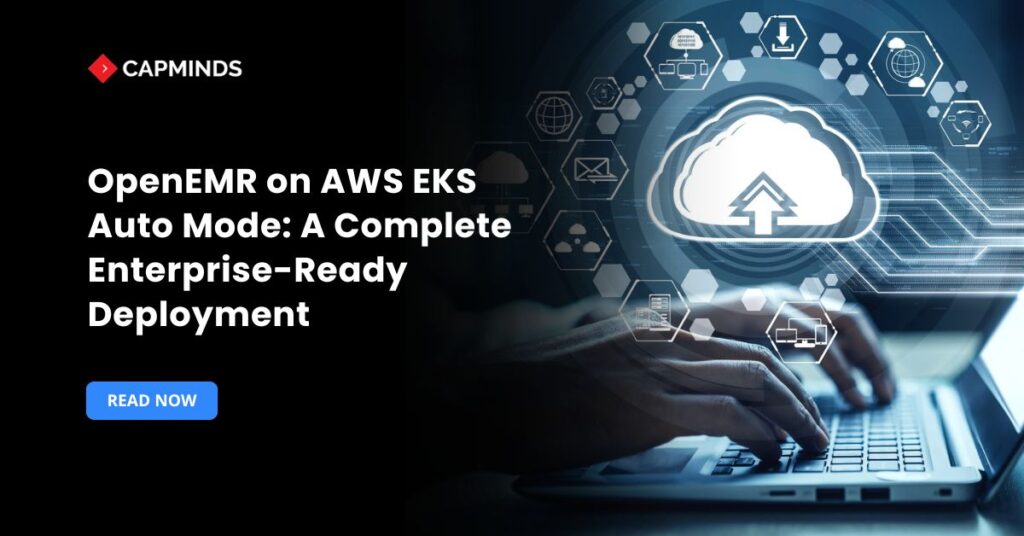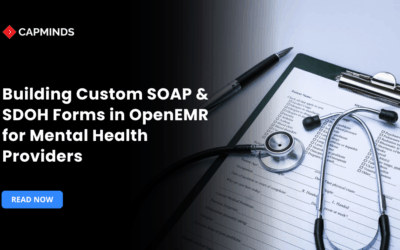OpenEMR on AWS EKS Auto Mode: A Complete Enterprise-Ready Deployment
OpenEMR is a widely used open-source electronic medical record system. Since its release, thousands of healthcare practices from all over the world have been considering OpenEMR. Now, OpenEMR has become the most valuable Health IT Solution with thousands of installations serving tens of millions of patients worldwide. Despite its widespread use, healthcare IT teams may find it intimidating to use OpenEMR on a large scale. Complex infrastructure configuration, peak-hour performance bottlenecks, disaster recovery planning, and stringent security/compliance regulations are challenges for many firms.
To address these challenges, the OpenEMR community has developed “OpenEMR on AWS EKS with Auto Mode,” a turnkey AWS solution that automates a production-grade deployment of OpenEMR on Elastic Kubernetes Service. This blog explains the architecture, key features & benefits, and technical architecture of this solution.
Challenges in Large-Scale OpenEMR Deployments
When implementing an open-source EMR system like OpenEMR, large healthcare companies and multi-facility clinics encounter many challenges.:
- Complex Infrastructure and Management: Web servers, databases, and caching, often on several machines, are needed to set up OpenEMR. Managing Kubernetes clusters, load balancers, SSL certificates, and backups by hand adds overhead.
- Scalability: During busy periods like for instance as in clinics with hundreds of concurrent users, the system must scale out to maintain performance. Self-managed or on-premise solutions sometimes have trouble auto-scaling.
- High Availability & Disaster Recovery: Healthcare systems that are essential to the mission cannot afford to be unavailable. In the event of an outage, deployments must support failover, span multiple Availability Zones, and enable quick recovery, even across regions.
- Security and Compliance: Information in the healthcare industry is very sensitive. Web protection, network isolation, fine-grained access controls, and encryption both in transit and at rest must all be implemented.
- Operational Overhead: Costly IT resources are used for ongoing processes, including patching, certificate renewal, log aggregation, and monitoring. Many hospitals want a managed solution that “just works” without constant manual upkeep.
The OpenEMR on AWS EKS Auto Mode solution packages AWS best practices into one automated framework, addressing all of the above at once.
Key Benefits and Features
This deployment offers many enterprise-ready features out of the box:
1. Streamlined, Automated Deployment
All infrastructure and application components are provisioned via Terraform and Helm/Kubernetes scripts. In about an hour (~25–60 minutes), you can have a complete OpenEMR AWS deployment with SSL, monitoring, and backups configured. No Kubernetes expertise is required, AWS EKS Auto Mode manages the nodes and control plane automatically.
2. High Availability & Scaling
The system is multi-AZ by design. The EKS control plane and etcd are automatically distributed across three Availability Zones for resiliency. OpenEMR pods run on an EKS Auto Mode cluster. Unscheduled pods initiate new nodes, idle nodes are drained when no longer required, and EKS Auto Mode uses Karpenter to dynamically grow EC2 nodes.
This guarantees that, without human assistance, the application can scale automatically from a small clinic to a large hospital. ElastiCache Serverless automatically scales caching, while Aurora Serverless v2 automatically modifies database capacity to match load. They operate together to sustain performance under erratic workloads.
3. Built-in Disaster Recovery
Cross-region recovery and automated backups are supported by all data services. Snapshots can be copied to different regions, and Aurora’s storage is distributed and fault-tolerant. RDS, EFS, and cache cross-region backup and restoration are automated via the provided scripts and Terraform modules. The system can be swiftly restored from backups in the event of a disaster.
4. Enterprise-Grade Security & Compliance
Security is enforced at every layer. The deployment places all workloads in private VPC subnets, with the Kubernetes API endpoint access restricted by IP.
- AWS WAFv2 protects the OpenEMR application from common web exploits.
- All persistent storage is encrypted with AWS KMS keys, ensuring granular encryption controls.
- Kubernetes employs a rigorous Pod Security Standards profile to stop privilege escalation and network policies to segregate pods.
- Role-Based Access Control restricts cluster management authority.
- Detailed logging is enabled: AWS CloudTrail logs all API activity, VPC Flow Logs track network traffic, and application logs are routed to CloudWatch Logs.
5. Cost Optimization
Because most components use serverless or auto-scaling modes, you pay only for what you use. For example, Aurora Serverless v2 charges per second for database capacity.
- ElastiCache Serverless for Valkey has a low entry cost of ~$6/month and auto-scales for caching.
- Estimates show that a small clinic deployment can run ~$385/month, while a mid-size hospital might be ~$816/month
- Even a large hospital costs ~$2,636/month, significantly lower than provisioning for peak load.
The embedded autoscaling ensures you don’t pay for idle capacity.
Related: Why Your OpenEMR AWS Bill Is Higher Than Expected (and How to Fix It)
6. Comprehensive Monitoring & Observability
By default, basic monitoring is activated. A complete monitoring stack, including Prometheus for metrics, Grafana for dashboards, Loki for log aggregation, Jaeger for distributed tracing, and AlertManager with Slack connection, can be installed with an optional one-command add-on for more visibility. This makes it possible for the OpenEMR microservices to have fine-grained observability and proactive alerts.
Technical Architecture
The solution’s architecture can be summarized as follows:
1. Compute
An Amazon EKS cluster in Auto Mode is the core. Auto Mode fully manages the data plane, it provisions and replaces EC2 worker nodes as needed and automatically applies security/OS updates. Bottlerocket OS and Kubernetes 1.33 are used by the cluster’s nodes.
AWS’s lightweight, container-optimized Linux, Bottlerocket, comes with just the necessary apps and, for further protection, enforces SELinux and a read-only filesystem. With a SLA-backed endpoint, AWS makes sure the EKS control plane operates across three AZs.
2. Database
The MySQL 8.0 database backend uses Aurora Serverless v2. Aurora v2 automatically scales database capacity up and down in seconds to match demand, with multi-AZ high availability. You pay per second for actual usage, making it cost-effective. Aurora’s distributed storage is self-healing and replicates data across AZs to protect against data loss.
3. Caching
For session and transient data caching, the deployment uses Amazon ElastiCache Serverless with Valkey. This caching layer auto-scales and supports multi-AZ failover and cross-region replication, ensuring low-latency performance. Valkey’s compatibility with Redis means application code does not change, while AWS fully manages the caching fleet.
4. Storage
Shared file storage is on Amazon EFS. The file system is encrypted at rest and mounted on the nodes via the EFS CSI driver. This provides a common file store with high availability across AZs.
5. Security Layers
AWS WAFv2 protects the OpenEMR web endpoints with customizable rules. All networking is in a private VPC, with strict security groups controlling traffic. Sensitive secrets and data encryption are handled by AWS KMS. Kubernetes-level security includes NetworkPolicies and a Restricted Pod Security Standard. IAM roles and RBAC ensure that both AWS and Kubernetes permissions are scoped down tightly.
6. Monitoring & Logging
By default, CloudWatch is utilized for alarms, logs, and metrics. AWS CloudTrail and VPC Flow Logs are activated for network and API auditing. For end-to-end observability, the Prometheus/Grafana/Loki/Jaeger stack can be deployed and run inside the cluster.
This architecture adheres to AWS best practices by isolating each component for security, automating scaling and upgrades, and utilizing managed services when practical. By using EKS Auto Mode, we inherit AWS’s hardened AMIs and autoscaling capabilities.
Architecture Deep Dive
Below is a simplified view of the major components in the deployed architecture:
1. EKS Auto Mode Cluster
AWS manages the EC2 nodes and the control plane. The control plane runs across three AZs. Worker nodes use Bottlerocket OS, which is pre-hardened for containers. EKS Auto Mode automatically provisions EC2 instances as Kubernetes NodePools and ties into the Karpenter autoscaler. Nodes have a 21-day maximum lifetime.
2. OpenEMR Application Pods
The OpenEMR PHP/PHP-FPM application runs in containers, behind an AWS Application Load Balancer. Ingress is managed by cert-manager for TLS certificates, and traffic passes through AWS WAF rules. PodDisruptionBudgets are configured to maintain at least one replica during updates.
3. Database Layer
Aurora Serverless v2 provides the MySQL-compatible cluster. It lives in private subnets and spans three AZs. Without any downtime, capacity automatically grows according to traffic, even between writer and reader nodes. It is possible to plan cross-region copies and take regular snapshots automatically.
4. Cache Layer
A Valkey cluster is used for session caching and any ephemeral data. It is configured in Serverless mode, which scales out shards on demand and supports multi-AZ. This ensures fast response times for session lookups without requiring pre-allocated Redis instances.
5. Storage/Backups
Any file uploads or backups of OpenEMR attachments use an encrypted Amazon EFS file system. EFS backups can be configured to run snapshots. There are also scripts for logical backup/restore of the database and config, facilitating point-in-time recovery.
6. Security & Compliance Services
- The OpenEMR endpoint is protected from the OWASP Top 10 attacks by AWS WAFv2.
- Volumes and data are encrypted using AWS KMS; for granular control, the deployment generates unique customer-managed keys for every service.
- Networking: EKS worker subnets are private, and the NAT Gateway allows EKS to pull images and reach AWS APIs. VPC Flow Logs capture network traffic metadata.
- Logging & Auditing: CloudWatch Logs aggregates application and system logs.
- CloudTrail logs every AWS API call.
- It is also possible to enable Kubernetes audit logging for the cluster. To comply with HIPAA and other laws, these logs may be kept on file.
Observability Add-Ons: The cluster is the only environment in which the Prometheus/Grafana/Loki/Jaeger stack operates. Jaeger traces can be enabled using the OpenEMR PHP application, Loki gathers stdout logs from containers, and ServiceMonitors scrapes metrics from OpenEMR pods and infrastructure services. This comprehensive stack provides full visibility into performance and user flows.
How This Complements Existing Deployments
This solution is not meant to replace all other deployment methods. Instead, it offers an additional option for organizations that need enterprise-grade AWS infrastructure with minimal ops overhead. It’s ideal for:
- Strict compliance, scalability, and high availability are necessary for large multi-facility hospitals and clinics.
- Mid-sized businesses that wish to use the cloud to handle infrastructure management.
- CIOs and CTOs in the healthcare industry who seek predictable expenses (pay-per-use) and who favor Terraform and managed services over manual deployment.
- AWS is already being used for various workloads by OpenEMR customers in AWS-centric settings.
Smaller clinics or on-prem deployments may continue using traditional LAMP stacks or simpler container setups. But for any organization facing rapid growth, heavy concurrent usage, or strict uptime SLAs, the EKS Auto Mode approach provides resilience and elasticity that few other deployment strategies can match.
Related: A CIO’s Guide to Secure and Scalable OpenEMR Deployments
Empower Your Practice with CapMinds’ OpenEMR Cloud Deployment Services
Transform your OpenEMR experience to the next level with CapMinds’ complete suite of OpenEMR services, built for scalability, security, and performance on AWS.
Whether you’re a growing clinic or a multi-facility enterprise, our experts ensure a seamless transition to a production-ready cloud environment.
We help healthcare organizations deploy, customize, and optimize OpenEMR for real-world clinical efficiency and compliance.
Our Key OpenEMR Services Include:
- Complete OpenEMR Services – Customization, integration, and ongoing support tailored to your workflow.
- OpenEMR Cloud Deployment on AWS – High-availability, auto-scaling infrastructure using EKS Auto Mode.
- Production-Ready Implementation – Enterprise-grade setup with SSL, WAF, KMS encryption, and backup automation.
- OpenEMR Optimization & Monitoring – Performance tuning, observability, and disaster recovery solutions.
Modernize your OpenEMR with CapMinds. Book your Free 1:1 Consultation Call!




